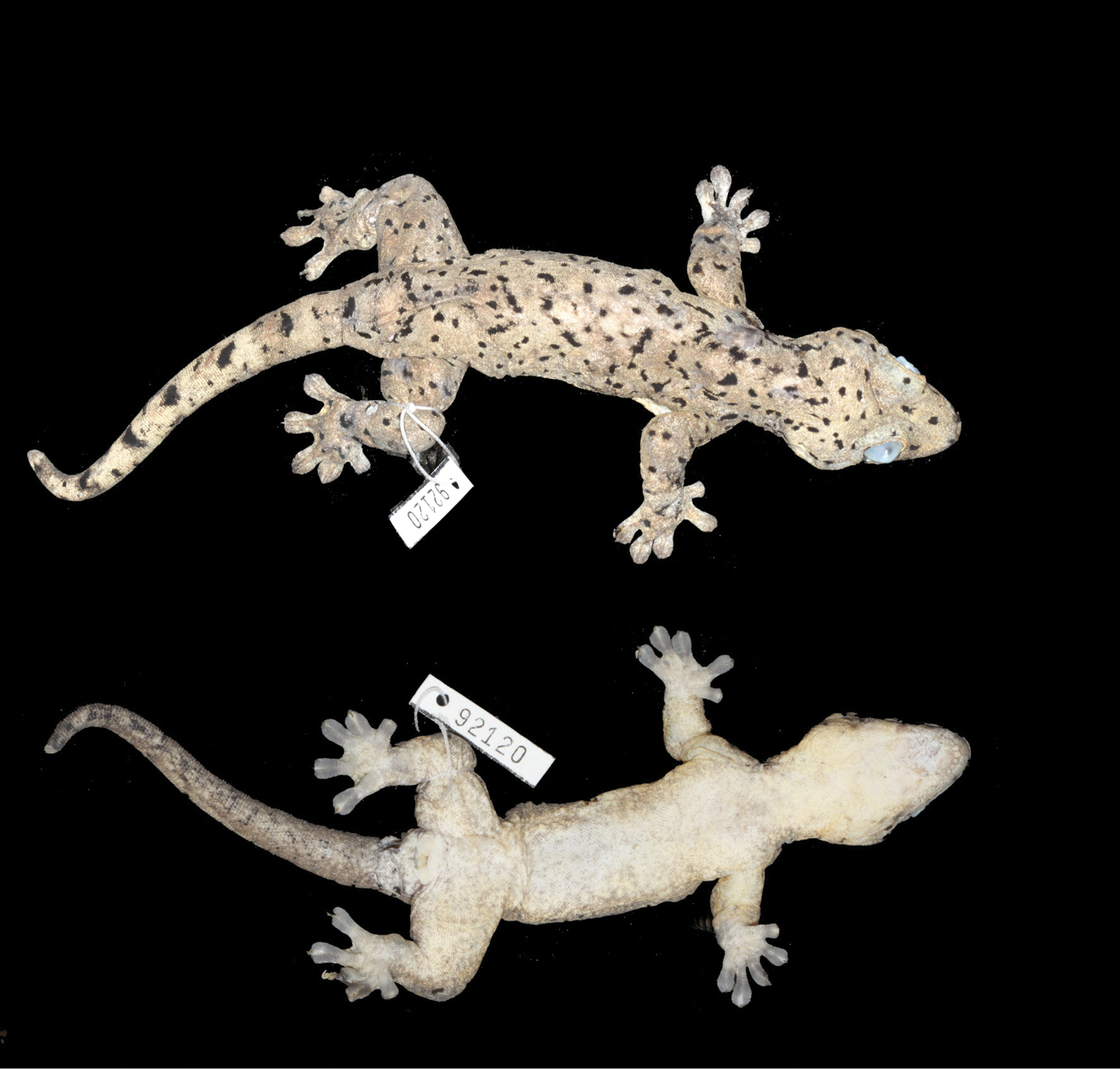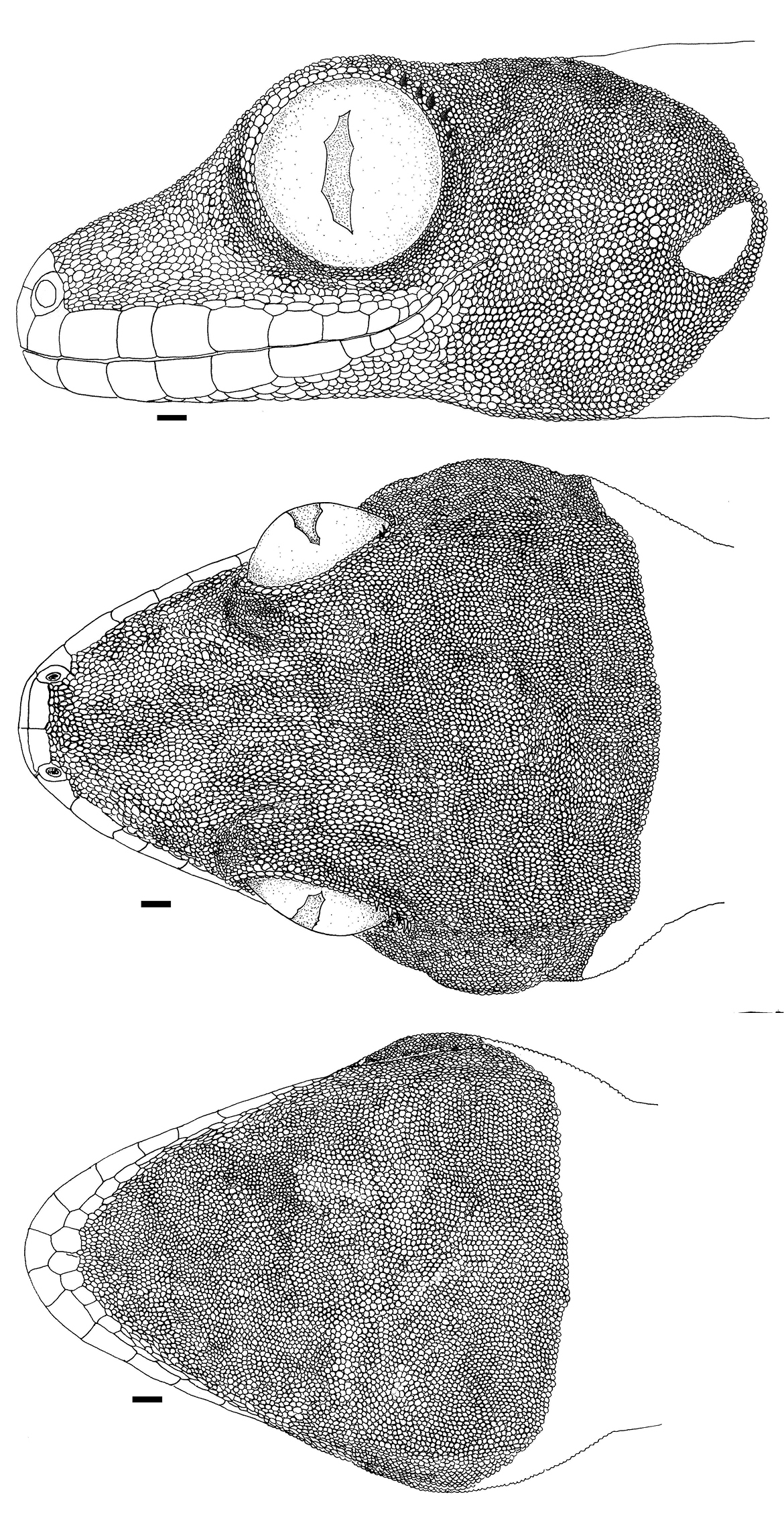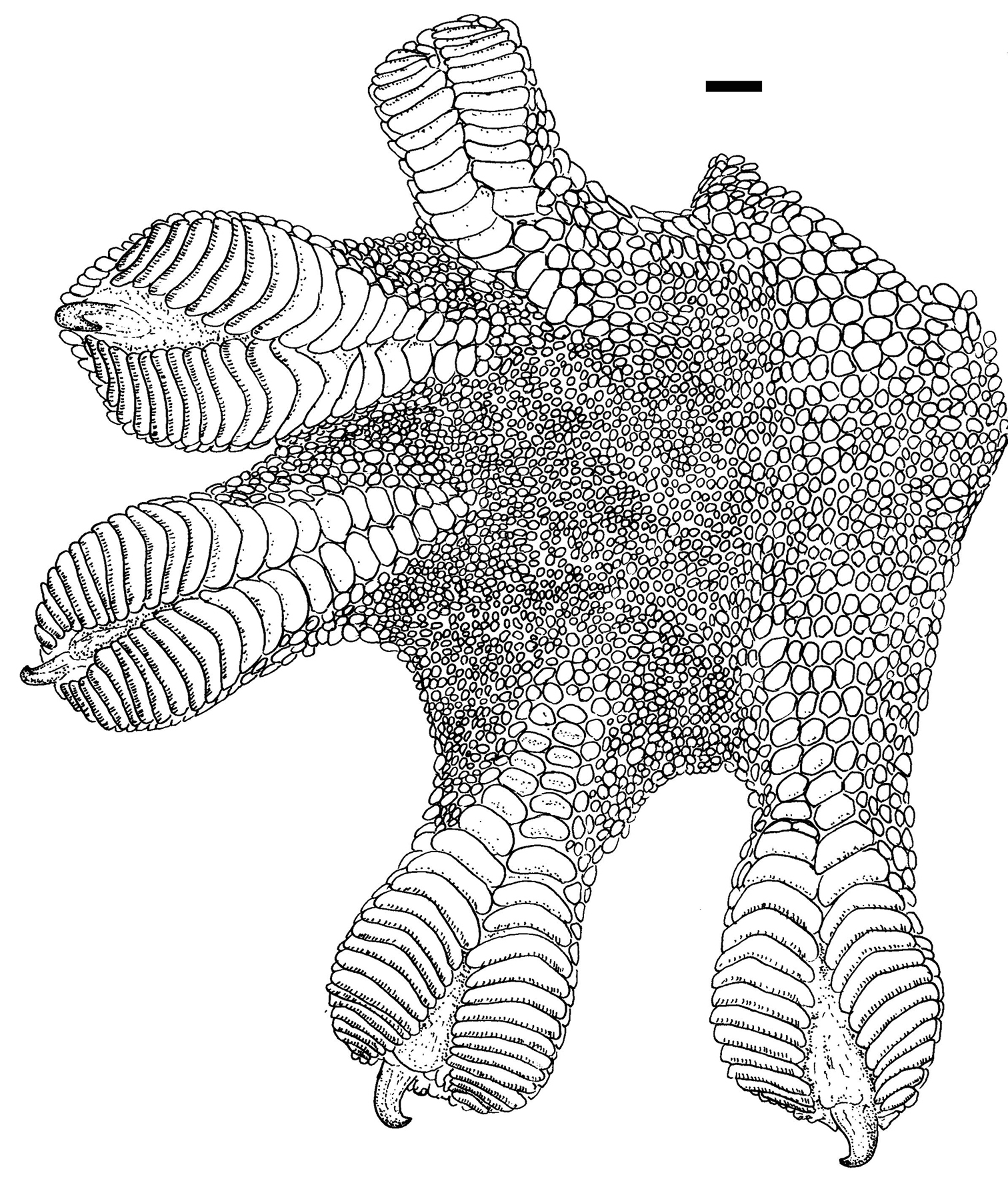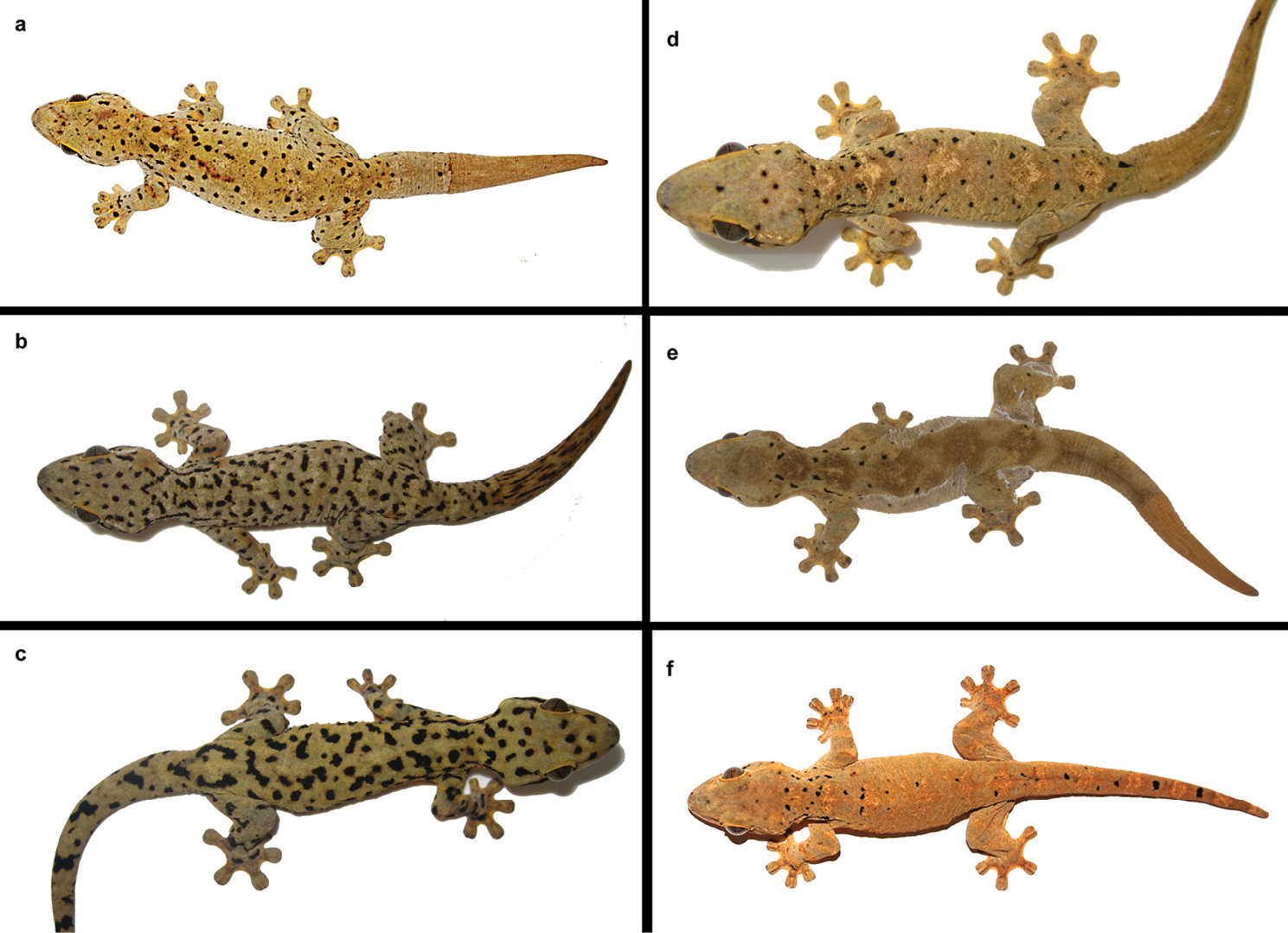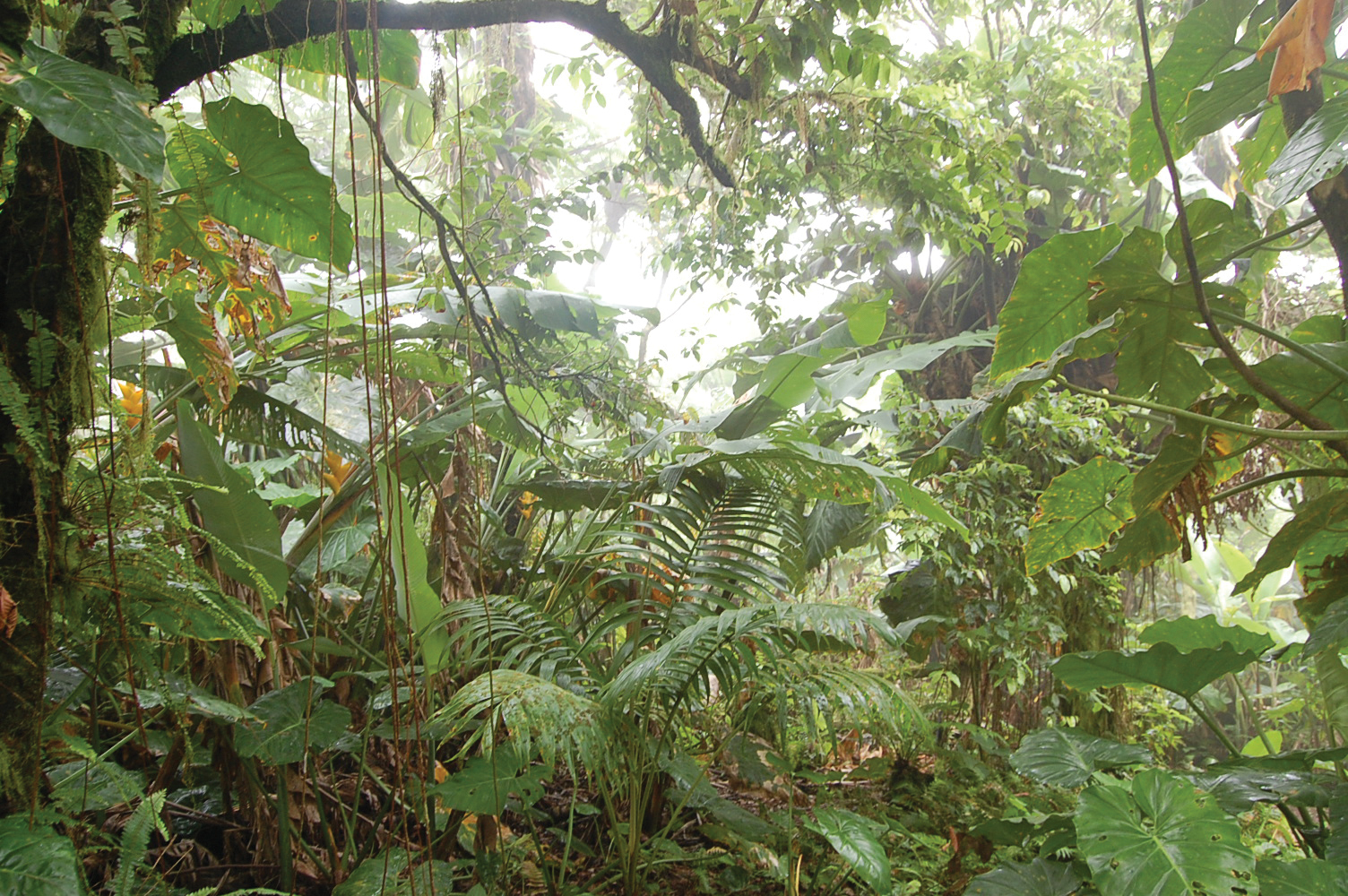(C) 2011 Gunther Köhler. This is an open access article distributed under the terms of the Creative Commons Attribution License, which permits unrestricted use, distribution, and reproduction in any medium, provided the original author and source are credited.
For reference, use of the paginated PDF or printed version of this article is recommended.
We describe a new species of Thecadactylusfrom the Caribbean island of Sint Maarten. The new species differs from all other species in the genus by having a distinct dorsal pattern of numerous irregular but sharply deliminated black spots and blotches on an otherwise almost patternless background.
Gekkonidae, Lesser Antilles, new species, Reptilia, Sint Maarten, Squamata, Thecadactylus
Turnip-tailed geckos (genus Thecadactylus)
are moderate-sized to large geckos distributed from southeastern Mexico
across most of Central America and mesic tropical South America, and
also occupy the Lesser Antilles (
In 2010, several specimens of a distinctly spotted Thecadactylus
were collected on the island of Sint Maarten (also known as Saint
Martin), Lesser Antilles, and imported to Germany by a pet trade
dealer. In order to verify the geographic origin of these individuals,
Stephan Prein and Maciej Oskroba visited Sint Maarten in April 2011.
They indeed encountered Thecadactylus
there and found that all specimens from this island had a distinctly
spotted but otherwise patternless dorsum. A research of the pertinent
literature revealed that this peculiar form had already been reported
and illustrated from Sint Maarten (
A list of the comparative specimens examined is provided in the Appendix. Abbreviations for museum collections follow those of
urn:lsid:zoobank.org:act:0F9770AC-C296-462A-B23F-F3356ECC4BE5
http://species-id.net/wiki/Thecadactylus_oskrobapreinorum
Figs 1–3SMF 92120, an adult male from Sint Maarten, near the southern edge of the village of Dawn Beach, 18.042°N, 63.023°W, 45 m elevation; collected 12 April 2011 by Stephan Prein and Maciej Oskroba.
SMF 92194, 92721–29, same collecting data as holotype.
A species (SVL in largest specimen examined 99 mm) of the genus Thecadactylus(sensu
Adult male as indicated by partially everted hemipenes; SVL 95.5 mm; tail length 75.0 mm, tail complete; tail almost round in cross section, tail height 6.9 mm, width 7.6 mm; axilla to groin distance 37.0 mm; head length 24.5 mm; snout length 12.2 mm; head width 20.5 mm; shank length 16.2 mm. Rostral large, rectangular, about twice as wide as deep, visible from above, and with a long median cleft extending from posterior margin; 2 relatively large, rectangular postrostrals; nostril bordered by rostral, first supralabial, 3 small postnasals and one postrostral; scales on snout and on loreal region granular, mostly keeled; 22 loreal scales in a longitudinal line between rostral and orbit; scales on upper and posterior portions of head slightly smaller than on snout; scales in supraorbital region not differentiated from those on upper part of head; supraciliary flap bordered by a double row of scales, 18 in outer row between anterior border of flap and a point above center of eye, with 7 small spines posteriorly; pupil four-lobed, vertically elongate; 8 supralabials to level below center of eye, total number 10, anterior supralabials subequal in size, below eyes decreasing in size; ear opening obliquely oval, 3.0 x 1.5 mm (length x height) distinctly smaller than eye (eye length 6.1 mm); mental larger than adjacent scales, pentagonal; 2 relatively large postmentals, at each side followed by a row of smooth, polygonal scales, decreasing in size posteriorly, and in contact with anterior infralabials; scales on chin granular, mostly pointed; scales on throat small, round, convex, juxtaposed; 8 (right)–7 (left) infralabials to level below center of eye, total number 10; infralabials mostly large, smooth, quadrangular to pentagonal, posterior ones smaller; dorsum of body with convex, juxtaposed to subimbricate scales with rounded posterior margins, about twice as large as scales on snout, largest dorsal scales about 0.35 x 0.29 mm (length x width); about 72 median dorsal scales in one head length; ventral scales at midbody smooth, juxtaposed to subimbricate with rounded posterior margins, forming oblique rows, about 0.42 x 0.39 mm (length x width); about 45 ventral scales in one head length; a gradual transition between dorsal and ventral scales; 218 scales around midbody; caudal scales smooth, imbricate, with rounded posterior margins, slightly larger ventrally; scales on limbs mostly smooth, subimbricate, with rounded posterior margins, equal to, to larger than dorsals; scales on posterior surfaces of forelimbs and on posterior and upper surfaces of hind limbs small, granular; fingers and toes depressed with a middorsal elevation, connected by a basal web; subdigital lamellae forming two transversely enlarged rows, divided by a median sulcus, 20 under fourth toe, 19 under fourth finger; claw on distal extremity of distal sulcus.
Coloration after one month in preservative (70% ethanol) was recorded as follows: Dorsal surfaces of head, body, limbs, and tail grayish brown with numerous irregular but sharply deliminated, black spots and blotches; ventral surfaces of head, body, and limbs cream with gray shading and faint gray reticulations; widened lamellae of fingers and toes gray; ventral surface of tail brown with dark grayish brown reticulations.
The paratypes agree well with the holotype in general appearance, morphometrics and scalation (see Table 1). Variation of coloration in life is illustrated in Fig. 4. As can be seen, the number and distribution of the dark spots and blotches varies between individuals as does the background color which ranges from pale pearl gray over pale grayish yellow to grayish olive. Scale size differences in certain areas of gular and temporal region of male holotype are probably the result of bites from other males in territorial fights. The damaged parts of the skin are covered by smaller granular scales as it is typical for scar tissue.
The name oskrobapreinorum is a construction in the genitive plural honoring Maciej Oskroba and Stephan Prein, two German herpetoculturists who directed our attention to this new species and made field observations on this gecko on the island of Sint Maarten.
All type specimens were collected at night while the lizards were active on the lower parts of the trunks of large living trees within or at the edge of forested areas (see also Fig. 5). From 11–16 April 2011, the air temperature (measured in the shade) varied at the type locality from 21.1–23.7°C (mean 22.7°C) in the morning hours and 24.6–28.2°C (mean 26.6°C) in the afternoon.
As currently known, Thecadactylus oskrobapreinorum
is restricted to the island of Sint Maarten, Lesser Antilles. Although
the type locality is in the Dutch portion of the island, the species
is also known from several localities in the French portion (see records
in
The distinctive dorsal pattern in Thecadactylus oskrobapreinorum
appears to be a fixed character in this species since no individuals
without dark spots on a otherwise patternless dorsum have been
documented (see also a photo of a specimen of this species in
We have not examined the types of the nominal species placed in the synonymy of Thecadactylus rapicauda (following e.g., Peters and Donoso-Barros 1970,
Holotype of Thecadactylus oskrobapreinorum (SMF 92120). SVL = 95.5 mm.
Head of holotype of Thecadactylus oskrobapreinorum (SMF 92120). Scale bar equals 1.0 mm.
Right hind foot of holotype of Thecadactylus oskrobapreinorum (SMF 92120). Scale bar equals 1.0 mm.
Thecadactylus oskrobapreinorum in life (specimens not preserved; all from Sint Maarten, Lesser Antilles). Photos a, e by Gunther Köhler; b, c, d by Stephan Prein, f by Maciej Oskroba
Habitat at the type locality of Thecadactylus oskrobapreinorum on Sint Maarten, Lesser Antilles. Photo by Maciej Oskroba
Selected measurements, proportions and scale characters of Thecadactylus oskrobapreinorum and Thecadactylus rapicauda. Range is followed by mean value and standard deviation in parentheses. For abbreviations see text. For tail length, only complete original tails were measured.
| Thecadactylus oskrobapreinorum ♂ 4♀ 4 | Thecadactylus rapicauda ♂ 11♀ 9 | ||
|---|---|---|---|
| SVL | ♂ | 86.0–96.5 (90.6 ± 3.83) | 74.0–95.0 (85.5 ± 6.87) |
| ♀ | 87.0–99.0 (94.0 ± 4.85) | 79.0–119.0 (93.9 ± 11.65) | |
| Tail length | ♂ | 75.0–76.0 (75.3 ± 0.47) | 65.0–72.0 (68.5 ± 3.50) |
| ♀ | 71.0–83.0 (77.0 ± 6.00) | 75.0–76.0 (75.3 ± 0.47) | |
| HL | ♂ | 22.6–24.5 (23.5 ± 0.67) | 18.2–24.7 (21.5 ± 1.75) |
| ♀ | 23.0–25.0 (24.3 ± 0.79) | 18.8–28.0 (23.2 ± 2.56) | |
| HW | ♂ | 17.3–20.5 (18.4 ± 1.25) | 14.7–19.9 (17.3 ± 1.95) |
| ♀ | 17.6–19.1 (18.2 ± 0.58) | 13.2–22.9 (17.9 ± 2.74) | |
| Shank length | ♂ | 13.2–16.2 (14.2 ± 1.21) | 10.0–14.5 (12.7 ± 1.29) |
| ♀ | 14.0–15.9 (14.5 ± 0.81) | 10.6–17.2 (14.3 ± 1.95) | |
| Axilla–groin distance | ♂ | 37.0–38.7 (37.6 ± 0.68) | 33.0–45.7 (39.1 ± 4.54) |
| ♀ | 32.5–43.0 (39.2 ± 4.14) | 37.7–49.5 (42.5 ± 3.83) | |
| Tail length / SVL | ♂ | 0.78–0.87 (0.83 ± 0.04) | 0.82–0.87 (0.85 ± 0.02) |
| ♀ | 0.72–0.90 (0.81 ± 0.09) | 0.78–0.87 (0.83 ± 0.04) | |
| HL / SVL | ♂ | 0.25–0.27 (0.26 ± 0.01) | 0.24–0.26 (0.25 ± 0.01) |
| ♀ | 0.25–0.27 (0.26 ± 0.01) | 0.24–0.27 (0.25 ± 0.01) | |
| Shank length / SVL | ♂ | 0.15–0.17 (0.16 ± 0.01) | 0.13–0.17 (0.15 ± 0.01) |
| ♀ | 0.14–0.16 (0.15 ± 0.01) | 0.13–0.17 (0.15 ± 0.01) | |
| Axilla–groin distance / SVL | ♂ | 0.38–0.43 (0.42 ± 0.02) | 0.41–0.53 (0.46 ± 0.03) |
| ♀ | 0.37–0.43 (0.42 ± 0.02) | 0.42–0.49 (0.46 ± 0.02) | |
| Subdigital lamellae of 4th toe | 16–20 (18.13 ± 1.17) | 18–23 (20.17 ± 1.62) | |
| Subdigital lamellae of 4th finger | 16–19 (17.88 ± 1.05) | 17–23 (19.67 ± 2.13) | |
| Number of SPL to level below center of eye | 6–8 (6.63 ± 0.70) | 8–10 (8.62 ± 0.62) | |
| Number of INL to level below center of eye | 8–10 (8.63 ± 0.70) | 7–8 (7.62 ± 0.49) | |
| Number of postrostrals | 2 | 2 | |
| Number of postmentals | 2 | 2 | |
| Number of medial dorsal scales in one head length | 72–92 (81.25 ± 7.60) | 64–88 (75.15 ± 8.24) | |
| Number of medial ventral scales in one head length | 44–56 (49.00 ± 4.24) | 34–52 (40.62 ± 4.68) | |
Exportation permits were provided by Mervyn Butcher, Government of St. Maarten, Sint Maarten. For the loan of and/or access to specimens we thank William E. Duellman and John E. Simmons, University of Kansas, Natural History Museum (KU), Lawrence. Sebastian Lotzkat, Frankfurt, provided unpublished morphological data pertaining to Panamanian Thecadactylus. We thank Aaron M. Bauer, Villanova, for comments on an early draft of the manuscript.
Thecadactylus rapicauda – Brazil: Maranhão: SMF 8378. Colombia: Melgar, Tolima: SMF 70233. Guatemala: Sitio Arqueologico Quirigua, 76 m: SMF 84018. Honduras: Isla de Utila, near Iguana Station: SMF 79871; Isla de Utila, 1 km S Rock Harbour: SMF 77098; west end of Isla de Utila: SMF 77099; Río Platano Biosphere Reserve, vicinity of Río Cuyamel, 15°34.43'N, 85°0.248'W, 170 m: SMF 85940–41; Parque Nacional Patuca, Matamoros, 150 m: SMF 80824–25. Nicaragua: Bartola at Río San Juan, 10°58.37'N, 84°20.35'W, 30 m: SMF 82103; Parque Nacional Saslaya, 13°42.84'N, 84°58.66'W, 400 m: SMF 82875–77; Biosphere Reserve Bosawas, near Wiso, 13°59.67'N, 85°19.70'W, 246 m: SMF 78555; El Recreo, S side Río Mico, 25 m: KU 113016. Panama: Volante: SMF 89601; Cerro Tebata, Bocas del Toro Province: SMF 83638. Surinam: no further data: SMF 8374. Trinidad: Hotel Robinson Crusoe, Scarborough: SMF 65848; Alefounder, Grafton Estate: SMF 65849, 66185, 66204; Prospect Estate: SMF 66829. Trinidad: no further data: SMF 8376. Venezuela: Puerto Caballo: SMF 8375; between Guaramaco and San Fernando: SMF 8377.
Thecadactylus solimoensis – Ecuador: Pastaza Province, Arutam Field Station, 700 m east from the Camp (coordinates of the Camp): 1°47.28'S, 77°48.31'W, 790 m: SMF 91034.







